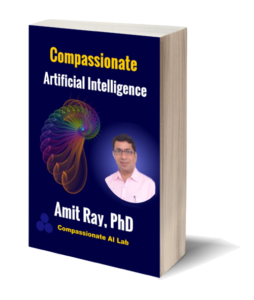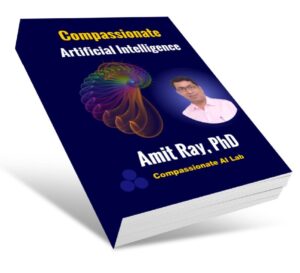Compassionate Artificial Intelligence Scopes and Challenges
With the advancement of AI and nuclear war technology, gradually mankind is moving towards a great threat. Compassionate artificial intelligence is the way to come out of that threat. Here, Sri Amit Ray talks about how artificial intelligence, neural networks, deep learning, reinforcement learning and other machine learning technologies can be used for designing advance compassionate artificial intelligence systems. Dr. Ray discusses the scopes, issues and frameworks to include compassion, kindness and empathy in future AI systems.

Need for Compassionate Artificial Intelligence Systems
One may question why it is useful to study compassion in machines at all. Compassion is an important part of human intelligence. The main objective of AI is to serve humanity in an intelligent manner. As AI technology is improving, serving humanity on the surface level is not sufficient. AI can serve humanity in much better way in a much deeper sense. Compassion, kindness and empathy are the components of higher human intelligence and to be true intelligent, artificial intelligence must incorporate them in the system. The scope and benefits of compassionate AI are many. Some of the requirements for compassionate AI are as follows:
Robots are leaving the realm of the industry and entering into our homes and workplaces. Humans not just interact with information but also with emotions and feelings. Robots are required to be soft and compassionate towards human.
They are required for health care, education and removing the loneliness of people.
Compassionate artificial intelligence systems are required to stop mass destruction weapon systems. The rapid decision-making capabilities of AI systems are now used for launching nuclear weapons in ships and submarines, especially for preventing counterattacks. AI is also used to control non-nuclear weapons including unmanned vehicles like drones and cyberweapons. In this competitive age, it is almost certain, that if some-country or someone turn AI into a full-fledged automated weapon system, everyone else will do that too. Initially, it may be just for their own defense but subsequently that will be used for mass destruction. The purpose of compassionate artificial intelligence systems is to develop inbuilt system that can stop and disobey the instructions of evil forces. Evil force can be a machine, algorithm or human.
Classification of Compassionate AI systems:
In the book Dr. Ray argued that compassionate AI systems can be classified into three groups. They are; Narrow Compassionate AI, General Compassionate AI and Compassionate Superintelligence. Narrow Compassionate AI tries to remove pains at individual level. General Compassionate AI tries to remove pains at social level, group level or country level. Compassionate Superintelligence tries to remove pains at higher levels of humanity.
Narrow Compassionate AI deals with narrow domains like looking after elderly people, helping blind people, assisting healthcare services. General Compassionate AI helps humanity at higher levels in an integrated infrastructure. It deals with social pains from higher levels. It will solve the social problems like monster government, political corruptions, terrorism, human exploitation, unethical journalism of paid news and false news, social media based depressions etc. Compassionate Superintelligence will save humanity from nuclear war, earth quake and other disasters.
What is compassion?
We all feel compassion when we see our family or friends in distress, and even animals feel compassion when they see their offspring are in pain. Compassion is a form of emotional engagement that is beneficial to the sufferer and the humanity. Compassion involves the sharing of feelings of another as a means of coming to an understanding and appreciation for how they feel. Hence, compassion is the feelings, inner experiences and related efforts to remove the pain of others. Compassion is an inbuilt human nature. It is the human potential to reach the higher evolution of consciousness. Compassion comprises of feelings, emotions, sentiment and understanding.
Characteristics of Compassionate AI
Compassion involves emotional engagement with some agent. The agent can be a person, group, machine, country etc. It also involves understanding their world. AI is humanizing technology.
 The Compassionate AI can care for someone by providing their needs but not necessarily moving into their personal world, walking in their shoes and sharing in their struggles, joys and challenges. Kanov et al. (2004) discuss that compassion consists of three facets: noticing, feeling, and responding. ‘Noticing’ includes being aware of a person’s suffering, either by cognitively recognizing this suffering or by experiencing an unconscious physical or affective reaction to it. ‘Feeling’ is defined as responding emotionally to that suffering and experiencing ‘empathic concern’ through accepting the person’s perspective and imagining or feeling their condition. Finally, ‘responding’ encompasses having a desire to act to alleviate the person’s suffering.
The Compassionate AI can care for someone by providing their needs but not necessarily moving into their personal world, walking in their shoes and sharing in their struggles, joys and challenges. Kanov et al. (2004) discuss that compassion consists of three facets: noticing, feeling, and responding. ‘Noticing’ includes being aware of a person’s suffering, either by cognitively recognizing this suffering or by experiencing an unconscious physical or affective reaction to it. ‘Feeling’ is defined as responding emotionally to that suffering and experiencing ‘empathic concern’ through accepting the person’s perspective and imagining or feeling their condition. Finally, ‘responding’ encompasses having a desire to act to alleviate the person’s suffering.
Implementing Compassionate Artificial Intelligence
Human emotions and feelings are like organic algorithms that respond to the environment. Now, machine learning algorithms are used to know human emotions by studying facial expression, words, gestures, speech patterns, tone of voice or body language. Emotion API of Microsoft Azure is one such example. IBM Watson Personality Insights is an example of human personality analysis.
AI is advancing rapidly at emotional intelligence. Face-tracking software is already advanced enough to analyze the smallest details in our facial expressions. The facial images are often analysed with deep learning algorithms which accurately classify them according to the feelings of the viewer. Emotion-Driven Reinforcement Learning is successfully for building narrow level compassionate models.
References:
- Ray, Amit. “From Data-Driven AI to Compassionate AI: Safeguarding Humanity and Empowering Future Generations.” Compassionate AI, vol. 2, no. 6, 17 June 2023, pp. 51-53, Compassionate AI Lab, https://amitray.com/from-data-driven-ai-to-compassionate-ai-safeguarding-humanity-and-empowering-future-generations/.
- Ray, Amit. “Calling for a Compassionate AI Movement: Towards Compassionate Artificial Intelligence.” Compassionate AI, vol. 2, no. 6, 25 June 2023, pp. 75-77, Compassionate AI Lab, https://amitray.com/calling-for-a-compassionate-ai-movement/.
- Ray, Amit. “Ethical Responsibilities in Large Language AI Models: GPT-3, GPT-4, PaLM 2, LLaMA, Chinchilla, Gopher, and BLOOM.” Compassionate AI, vol. 3, no. 7, 7 July 2023, pp. 21-23, Compassionate AI Lab, https://amitray.com/ethical-responsibility-in-large-language-ai-models/.
- Ray, Amit. “Compassionate Artificial Intelligence Scopes and Challenges.” Compassionate AI, vol. 2, no. 4, 16 April 2018, pp. 48-50, Compassionate AI Lab, https://amitray.com/compassionate-artificial-intelligence-scopes-and-challenges/.
- Ray, Amit. Compassionate artificial intelligence: Frameworks and algorithms. Compassionate AI Lab, 2018.
- Ray, Amit. “Compassionate Superintelligence AI 5.0: AI with Blockchain, BMI, Drone, IoT, and Biometric Technologies.” Inner Light Publishers,2018.
- Ray, Amit. “Brain-Computer Interface and Compassionate Artificial Intelligence.” Compassionate AI, vol. 2, no. 5, 1 May 2018, pp. 3-5, Compassionate AI Lab, https://amitray.com/brain-computer-interface-compassionate-ai/.
- Ray, Amit. “The 10 Ethical AI Indexes for LLM Data Training and Responsible AI.” Compassionate AI, vol. 3, no. 8, 8 August 2023, pp. 35-39, Compassionate AI Lab, https://amitray.com/the-10-ethical-ai-indexes-for-responsible-ai/.
- Ray, Amit. “Compassionate Artificial Intelligence Scopes and Challenges.” Compassionate AI, vol. 2, no. 4, 16 April 2018, pp. 48-50, Compassionate AI Lab, https://amitray.com/compassionate-artificial-intelligence-scopes-and-challenges/.
- Ray, Amit. “The 7 Pillars of Compassionate AI Democracy.” Compassionate AI, vol. 3, no. 9, 28 September 2024, pp. 84-86, Compassionate AI Lab, https://amitray.com/the-7-pillars-of-compassionate-ai-democracy/.
- Ray, Amit. “Compassionate AI Democracy: Eliminating Legal Gaps Between the Poor and Wealthy.” Compassionate AI, vol. 3, no. 9, 28 September 2024, pp. 84-86, Compassionate AI Lab, https://amitray.com/compassionate-ai-democracy-eliminating-legal-gaps-between-the-poor-and-wealthy/.
- Ray, Amit. “Compassionate AI-Driven Democracy: Power and Challenges.” Compassionate AI, vol. 3, no. 9, 16 September 2024, pp. 48-50, Compassionate AI Lab, https://amitray.com/compassionate-ai-driven-democracy-power-and-challenges/.
- Ray, Amit. “Integrating LLM AI Models for Ayurveda Medical Diagnosis and Treatment.” Compassionate AI, vol. 4, no. 10, 23 October 2024, pp. 54-56, Compassionate AI Lab, https://amitray.com/llm-ai-models-for-ayurveda/.
- Ray, Amit. “7 Limitations of Deep Learning Algorithms of AI.” Compassionate AI, vol. 2, no. 4, 5 April 2018, pp. 15-17, Compassionate AI Lab, https://amitray.com/7-limitations-of-deep-learning-algorithms-of-ai/.
Sources:
- Compassionate Artificial Intelligence: Frameworks and Algorithms, Amit Ray, 2018.
- Compassionate Artificial Superintelligence AI 5.0, Amit Ray, 2018

